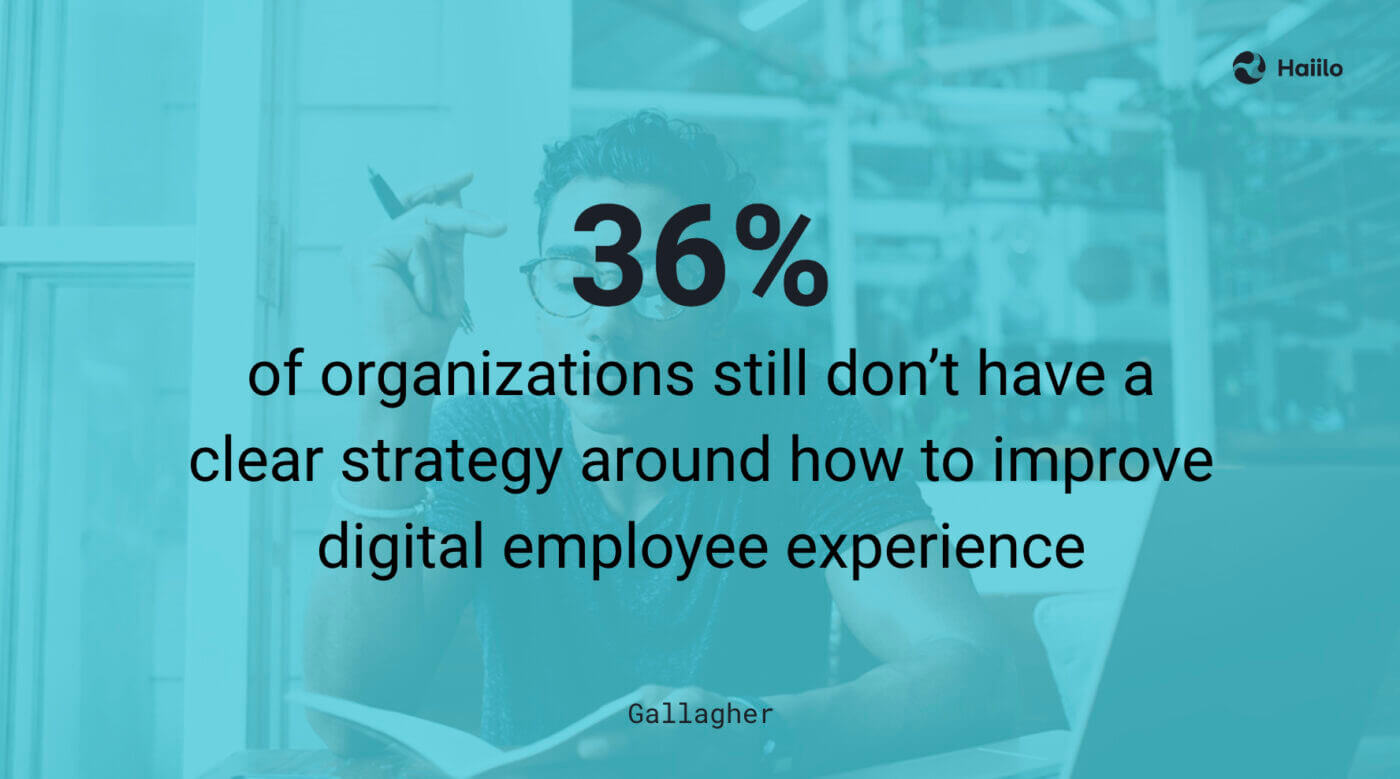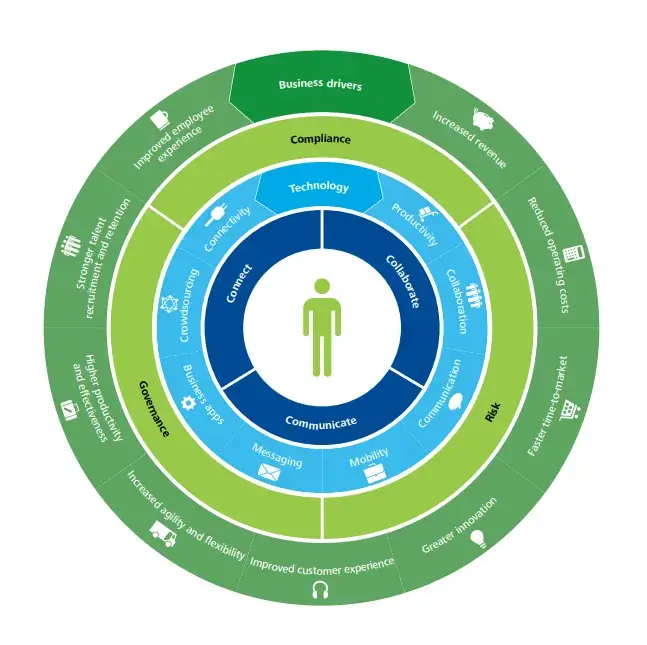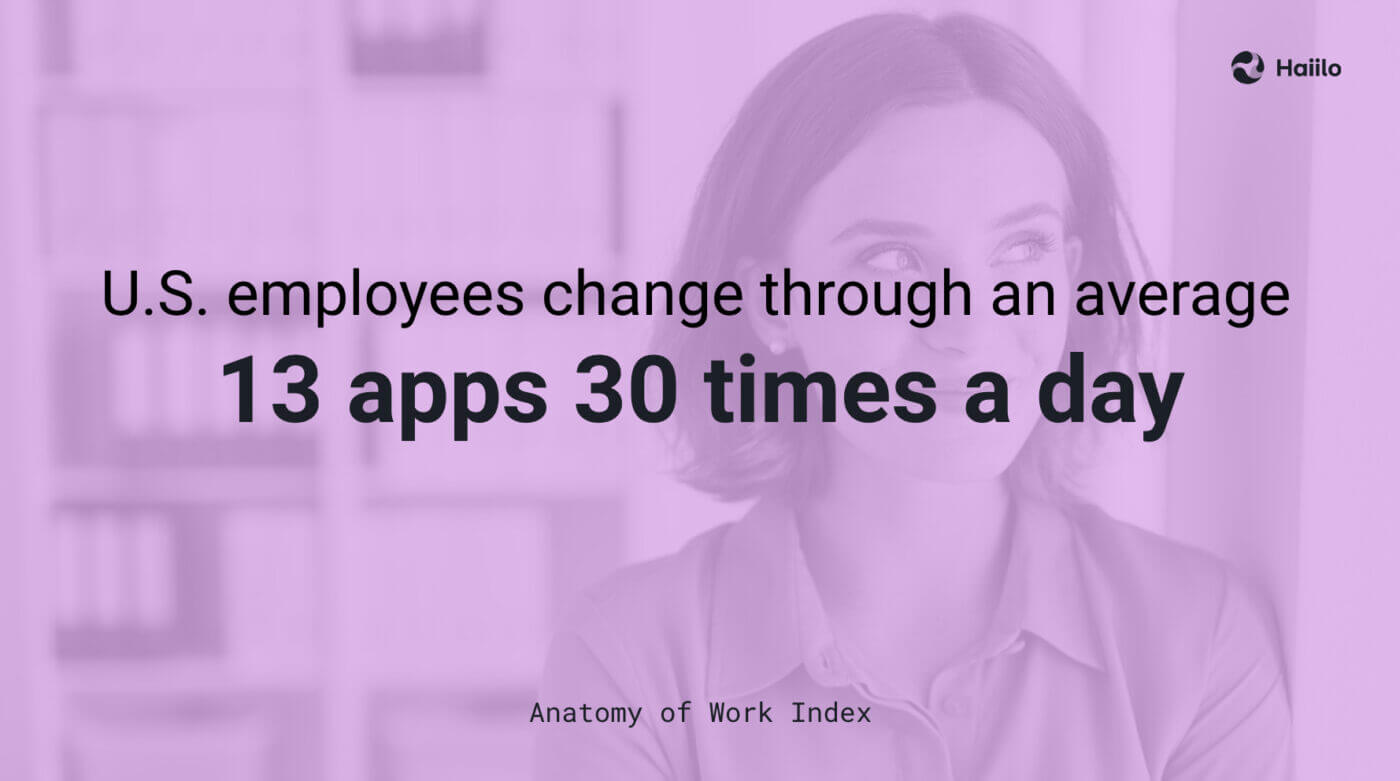Digital employee experience plays a critical role in shaping the overall employee experience in the workplace. Today, when employees depend on technology to communicate, collaborate, and get their work done, it is essential that organizations put more effort into enabling their people with the right technology.
Unfortunately, according to Gallagher, dissatisfaction with internal technology and channels is one of the biggest problems for larger organizations with more than 500 employees, resulting in poor digital employee experience. Yet, 36% of organizations still don’t have a clear strategy around how to improve it.

In this blog, we will define digital employee experience (DEX), explain the benefits of ensuring a positive experience, and provide the best practices for optimizing the ROI of your workplace tech ecosystem.
What Digital Employee Experience Really Is
We define digital employee experience as the overall perception of the usability and benefits of the tools employees use daily.
Frequent emergence and implementation of new workplace tools can easily lead to a nightmare. Too many unnecessary solutions and poor integrations between them tend to become the biggest employee productivity killer for employees.
Unfortunately, many workers still struggle to effectively connect with their colleagues and to uncover the information they need to be immediately productive. Moreover, in research by Deloitte, only 38% of employees thought that they were satisfied or very satisfied with work-related tools and technology.
Deloitte did one of the most comprehensive analysis of the emergence and characteristics of a digital workplace.
In their framework, they explain that a digital workplace is all about the employees’ ability to do their jobs by collaborating, communicating, and connecting with each other.

Other experts in the space of workplace technology also agree on the importance of technology in shaping the overall employee experience.
Harvard Business Review goes as far as equalling the technology to the workplace itself:
“As this trend persists, the technology experiences that employers provide will more or less define the employee experience — technology and workplace tools are, for all intents and purposes, the new workplace. As such, they’re becoming central in attracting and retaining new talent, fostering workplace culture, creating productivity, and more.”
The Importance of Digital Employee Experience In the Workplace
When implemented poorly, technology in the workplace often presents users with a disjointed, frustrating experience. Employers need to go beyond portals to build a unified experience platform that allows workers to interact seamlessly and collaborate efficiently with the organization and increase both engagement and productivity. And they are aware of that. According to research, 95% of organizations agree that a digital workplace is important.
By leveraging modern technology and establishing cross-functional, enterprise-level governance, organizations have the opportunity to streamline and simplify the transactions between the workforce and the enterprise, fostering greater engagement and driving more productivity in both the front and the back office.
These are the top reasons why the digital employee experience is so important.
Employee satisfaction and engagement
According to a study by Ultimate Software, 92% of workers said having technology that makes their jobs easier impacts their happiness with their jobs.
However, according to Qualtrics research, only 30% of employees said their experience with their company’s technology exceeds their expectations.
On the other hand, when employees are satisfied with their IT services and technology experience they are 158% more engaged at work.
📹 Check out our Masterclass about how to drive employee engagement in the workplace.
Employee productivity
Employees who work for firms that make apps available and highly accessible spend 17% less time on manual processes. Furthermore, solutions such as social intranets significantly reduce time wasted on searching for information and improve knowledge management, all resulting in higher employee productivity.
Employee retention
54% of CIOs agree that the ability of their workforce to easily access business applications has reduced attrition rates. Another research proved that employees have a 61% higher intent to stay with their employers if they feel they have the technology that supports them at work.
Talent attraction
Last but not least, 80% of employees prefer to work for digital leaders. And this is not limited to millennials but applies across the multigenerational workforce.
Try Haiilo to boost digital employee experience in your organization!
How To Ensure Positive Digital Employee Experience
Many employers still struggle to transform their organizations into true, functional digital workplaces.
The workplace tech ecosystem has become very complex, and there is no one-size-fits-all approach to follow.
However, there are a few critical steps every company should consider when implementing or improving their digital employee experience strategies.
Understand your workforce and deliver personalized experiences
The very first step in implementing your organization’s digital employee experience strategy is understanding your workforce, their preferences, cultural differences, and the nature of their jobs.
Today, workplace technology is still not providing consumer-grade, personalized user interfaces. Workplace programs aren’t reaching their potential due to lack of personalization resulting in low user adoption and engagement.
You can start with distributing a simple employee survey which can help you identify the current state of your employees’ digital experience and get insights about what is missing or needs improvement.
Only then you can deliver more personalized experiences that employees expect. But why is this so important?
Advanced workplace engagement apps, communication platforms, and productivity tools that focus on personalization can go a long way in making one’s working experience more enjoyable.
For example, with Haiilo you can create personalized news feeds based on employees’ interests, preferences, locations, languages, and much more. Internal communications and HR professionals can create and distribute personalized content to the right employees at the right time, resulting in much better readership and engagement. They can orchestrate content and communication across employee journeys.
Implement the right workplace tech stack
27% of workers estimate they lose up to an entire day every week on irrelevant emails and messages. Many remote and hybrid workers complain about the inability to connect with their teammates and collaborate efficiently.
These most common complaints from employees have shaped the list of some of the must-have workplace technologies every organization should have:
- Modern employee intranets that enable employers to connect their people, information, and tools under a single platform
- Instant messaging tools that help employees communicate synchronously
- Workplace productivity and project management software to help employees collaborate on projects and track their progress
- Document management systems to help organize and manage important company documents and files
Invest more in integrations
Integrations are critical for ensuring a seamless digital employee experience.
According to research, 70% of workers report having to enter the same data in multiple systems to get their job done, and the main culprit for that is a lack of integrations between the technology they work with daily.
As nicely put by Deloitte,
“By integrating the technologies that employees use, the digital workplace breaks down communication barriers, positioning you to transform the employee experience by fostering efficiency, innovation and growth. The key to success, however, lies in the effective implementation of a digital workplace strategy capable of driving true cultural change.”
Furthermore, U.S. employees change through an average of 13 apps 30 times per day, according to Asana’s Anatomy of Work Index 2021 report. And 26% of surveyed employees say app overload makes them less efficient at work.

Hence, it is important that organizations understand the benefits of integrating as many tools as possible into a single platform. Creating a central place from which employees can connect with their peers, find all important news, documents, and information, and access their favorite tools is a great way to avoid app overload and improve worker efficiency.
Make technology accessible to everyone
Accessibility is one of the biggest concerns for employers across the world, especially those who are dealing with frontline, mobile workforce without designated working space.
According to research, 20-25% of the global workforce telecommutes on a regular basis and 50% of the workforce is made up of front-line workers such as grocery store clerks, nurses, cleaners, warehouse workers, and bus drivers, among others.
Consequently, around 53% of employees say mobile apps improve business processes and productivity.
So when you are looking for digital solutions for your workplace, make sure that they offer native mobile apps and are optimized for those who work on the go.
Pay close attention to ease of implementation, user experience, and adoption
User-friendliness is a prerequisite for ensuring a positive digital employee experience. It impacts the ease of roll-out as well as overall user adoption and engagement.
According to research, nearly half of the employers in a supervisory role (46%) say they feel overwhelmed by technology at work, while 61% say they spend more time getting technology to work than they’d like.

Implementation of your workplace technology shouldn’t take months. If this is the case, the software may be too complicated and complex for your organization. Look for a sophisticated solution that is easy to implement, scalable, and can grow together with your company.
Leverage the Power of AI
Modern workplace technology providers have found ways to leverage AI to make employees better, faster, and more efficient at their jobs.
For example, Haiilo’s AI writing assistant can make internal comms and HR professionals write content 10 times faster compared to writing without the help of AI.
Consequently, 81% of respondents say that it is important or very important that the workplace software they purchase moving forward has AI functionality—and less than 5% say AI functionality is not important at all.
So if you are implementing a new solution in your workplace, or replacing an existing solution, make sure that you evaluate the vendor’s ambitions with AI. Look for both current AI functionalities as well as what’s coming next on the product roadmaps.










